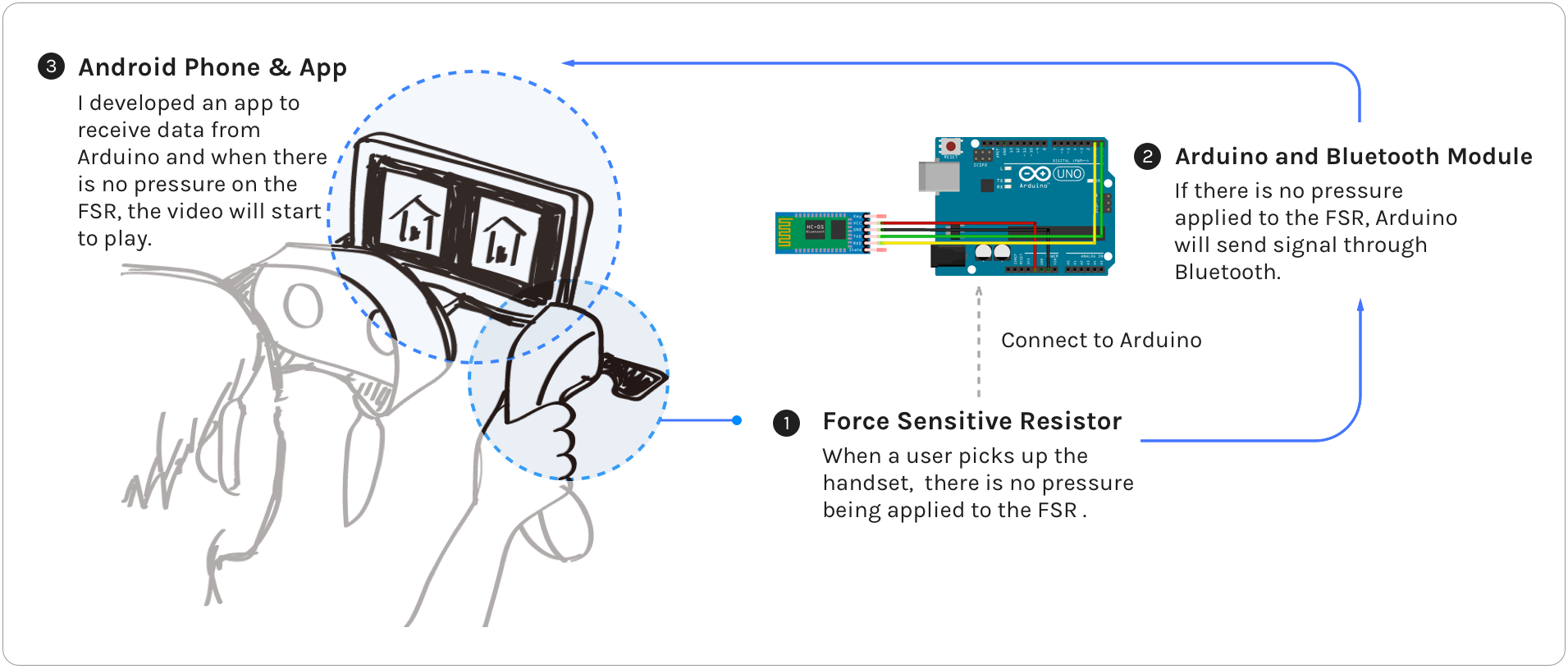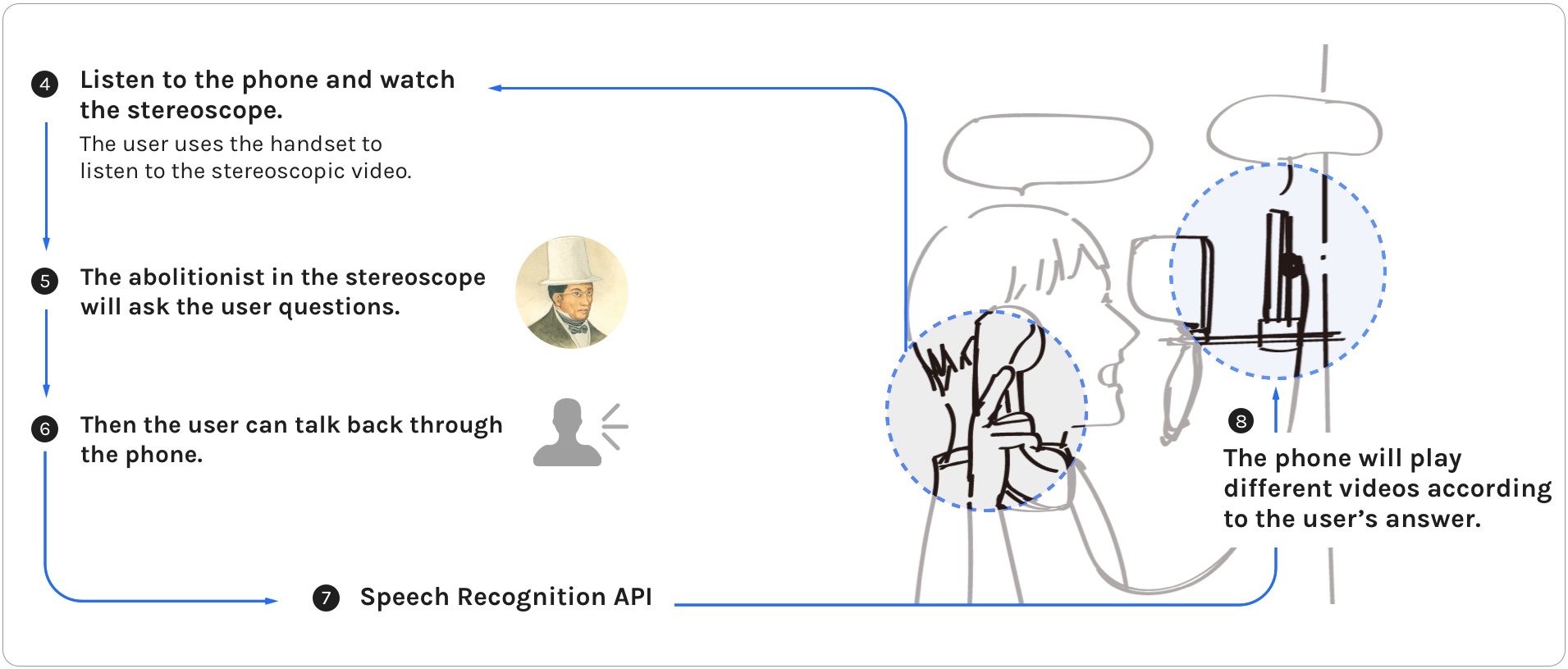Talk To Figure
Overview
This exhibit is designed to reveal immense history behind 227 Abolitionist Place Museum Heritage Center which is located in NYC. The goal of this project is to allow visitors to learn the history of African American and the Underground Railroad in NYC without too much reading. We build an interactive exhibit which can allow people to communicate with the abolitionist through a telephone. Also, visitors can watch the stereoscope to view the historical situation. The exhibit also serves to raise awareness of the roots of slavery in New York.
Role
Worked as User researcher, UX designer, and engineer in a 3-person team.
Collaborators
Harshita Nedunuri (User Researcher)
Yunfang Shi (UX/Industrial Designer)
Method & Tool
Method: Field Study, Persona, User Journey, MVP, Agile, video editing, 3D printing and Laser cutting.
Tool: Arduino, HTML, CSS, Javascript(voice recognition), Photoshop(stereoscopic images)
Design Process
Preliminary Research
New York was the second largest slave-owning state in the nation during the 1800s, but the area of Downtown Brooklyn was once an enclave of abolitionist activity. 227 Abolitionist Place was one of the safe houses along the Underground Railway for African-Americans and escaping slavery. After passing through several generations, the house was owned by Joy Chatel in 1998.
However, when I visited 227 Duffield Street, I found that this heritage center was close and Joy Chatel passed away in 2014. Now her daughter takes over the heritage center. Since it is impossible to enter the museum recently, I decided to focus more on the general experience of visiting a historical museum.
Online Survey
User Research
After carefully exploring the demographic data related to 227 Abolitionist Place, interviewing more than 30 potential users and analyzing their user journey, we categorized them into 3 segments: African American Community, Museum Enthusiasts and Academics, and Museum Stakeholders. For the African American Community and Museum Enthusiasts and Academics, they both mentioned that there are usually too much reading and not enough interaction, especially for kids and non-native speakers.
Persona
User Journey
Interview Experts
Ideation
Problem
How Might We
Improve human-site interaction in the museum?
After conducting user research and interviewing experts, we defined the problem and tried to improve human-site interaction in the museum. Then, we started our group brainstorming phase and conducted crazy 8s exercise. Our winning idea is to enable people to learn from the abolitionist through interactive storytelling while using telephone and stereoscopic video to communicate with the figure and visualize the abolitionist’s story.
Idea
Enable people to learn about stories of abolitionists through interactive storytelling.
Goals
Learning Goal
To gain a better understanding of how users learn about the history of abolition in New York through the portrait exhibit.
1. Does this exhibit help teach the historical context of abolition?
2. What did they learn about the abolitionist?
3. What information sticks with the user after they leave?
4. What information gets lost?
To gain a better understanding of how users react, emotionally, to the overall experience of learning about abolition in NY.
1. How did they feel during and after?
2. Was this experience memorable?
3. Will they share their feelings about the exhibit with other people?
Experience Goal
1. To gain a better understanding of how users interact with the kinesthetic experience of utilizing a telephone.
2. To gain a better understanding of how users interact with the auditory experience of utilizing a telephone (both listening and speaking).
3. To gain a better understanding of how users interact with the visual experience of utilizing a stereoscopic slideshow.
Measures of Success
Design & Prototyping
Key Components of the Prototype
Since anti-slavery movements happened in 19 century, to bring the visitors back to the time that the abolitionist lived in, I utilized Holmes stereoscope which was the most popular stereoscope in the 19th century, a telephone which can allow users listen to the figure’s story and talk to figure, and an abolitionist’s portrait which showcase the abolitionist’s appearance.
Contents
David Ruggles — A Leader Against Slavery
David was one of the most overlooked abolitionist in NYC. As the head conductor of the underground railroad in NYC, he helped as many as 600 fugitives, including well-known abolitionist, Frederick Douglass. He lived in downtown Manhattan (now Chinatown) but was extremely active all over NYC. Because of his great contribution to the anti-slavery movement and the connection between him and the Underground Railroad in New York City, I choose David Ruggles as the figure in the exhibit.
Iterations
To make the design fit users need and reach the goals that we set up, this project experiences three iterations. With each iteration, I identified new opportunities, responded to changes in the learning goal, experience goal and user needs. Each time after I finished the prototype, I would design new tasks for the prototype which aimed at aligning the design to users’ needs. It went through low-fidelity prototype to high-fidelity prototype.
01
For the first prototype, my goal is to test the feasibility of utilizing a telephone and a viewport to enable people learning from an abolitionist’s lived experience. In this term, I focused on whether this installation could help them learn and memorize the figure’s story or not. I developed a low-fidelity prototype with carboard. Also, I utilize my phone as the screen in the viewport.
Result
In the interviews, the majority of the interviewees were satisfied with the idea and its interactivity and they would recommend this exhibit to their friends. However, many testers indicated that they had sight issue since I did not utilize stereoscopic glasses in this prototype and thus they would see two separate screens in the viewport. Moreover, they also mentioned that the height of the viewport should be adjustable or they needed to lean on the wall to see the video. They also mentioned that the video started suddenly and they were not prepared to view the video after they picked up the telephone handset.
02
In this term, I tried to improve the prototype and solve all the problems in the previous tests. I replaced the viewport with the stereoscope and transformed the images in the video into stereoscopic images. To solve the problem that the video starts too sudden and users are not prepared for the interaction, I used Arduino and a force-sensitive sensor to detect when a user pick up the telephone handset and trigger the video to play. I also added simple audio instructions. Moreover, we designed tracks for the viewport so that users can adjust the height of stereoscope.
Result
When it comes to testing, a majority of the interviewees were satisfied with the interaction with the telephone and stereoscope. Also, they rated this exhibit in terms of educational value a high score. Yet, some of them suggested that the exhibit should be more interactive. They even expected they could talk with the figure when they interact with the telephone.
Final Prototype
In this term, I replaced the contents, Harriet Tubman’s story, with David Ruggles' lives experience which is directly connected to the Underground Railroad in New York. I also tried to make the exhibit more interactive and integrate the voice recognition technique into the exhibit, enabling the figure to have memory and personality. Moreover, I improved the shape of the stereoscope and made it more like the style of Holmes stereoscope which is regarded as the most common one and remained in production for a century. I also changed the materials of the prototype to make sure it is more accessible and secure.
Process
To make the prototype more secure and accessible and add voice recognition technique, we used 3D modeling, 3D printing, laser cutting to build the prototype. Also, I developed a web app which can allow users use their voice to control the video.
Development & How it works
User Journey and User Flow
Result
Demo for the voice recognition
To show more details of David Ruggles’ stereocopic video and also showcase how to interact with the figure through voice.
Evaluation
I found that the testers were amazed at that they can talk to the figure and figure would give them different feedback based on their answers. They enjoyed the interaction with the abolitionist and also hoped to have more conversations with David Ruggles. Even though they all never heard David Ruggles before, most of them enjoyed his story and remembered David Ruggles’ story after interacting with the figure. They also rated high scores in terms of educational value.
Accessibility
For museum, it is important to ensure that its facilities, exhibitions, and services are accessible to all individuals, including kids and people with disabilities. As a result, we also came up with several solutions to deal with this problem. Users can not only adjust the height of stereoscope, they can also adjust the distance of stereoscope.




















